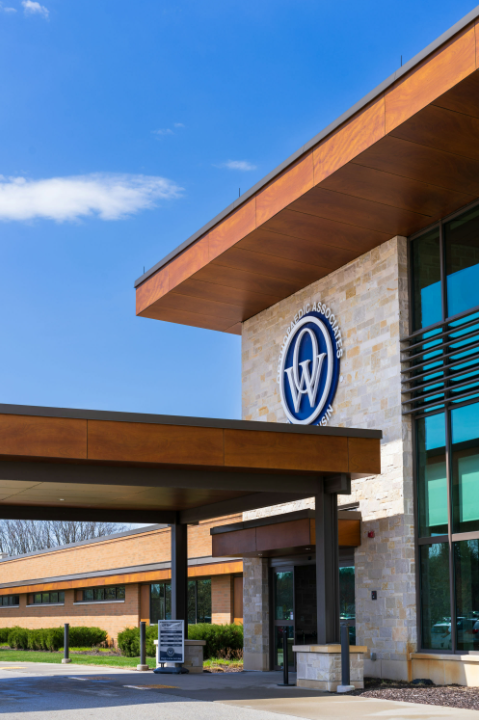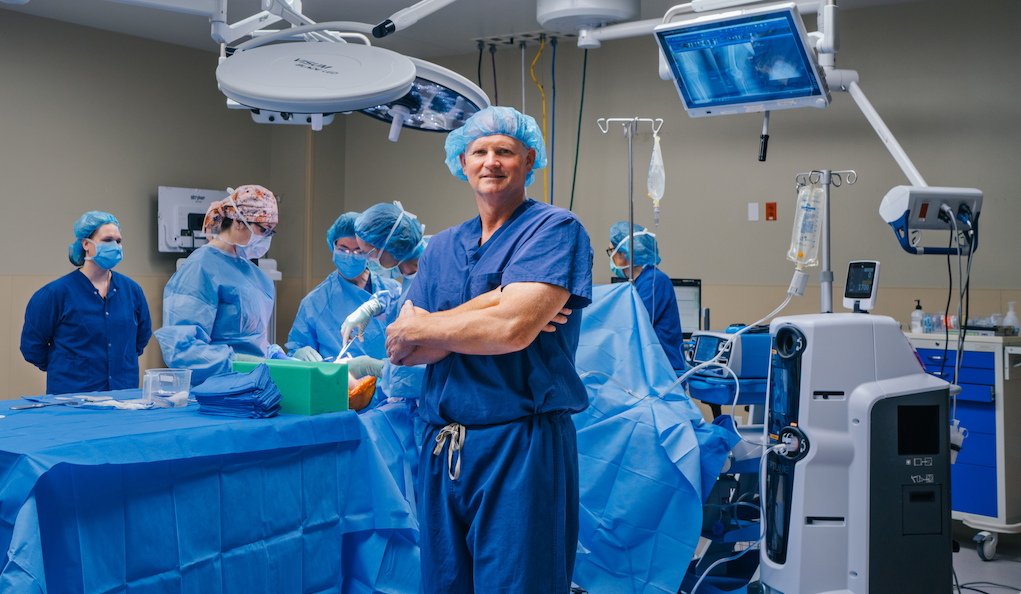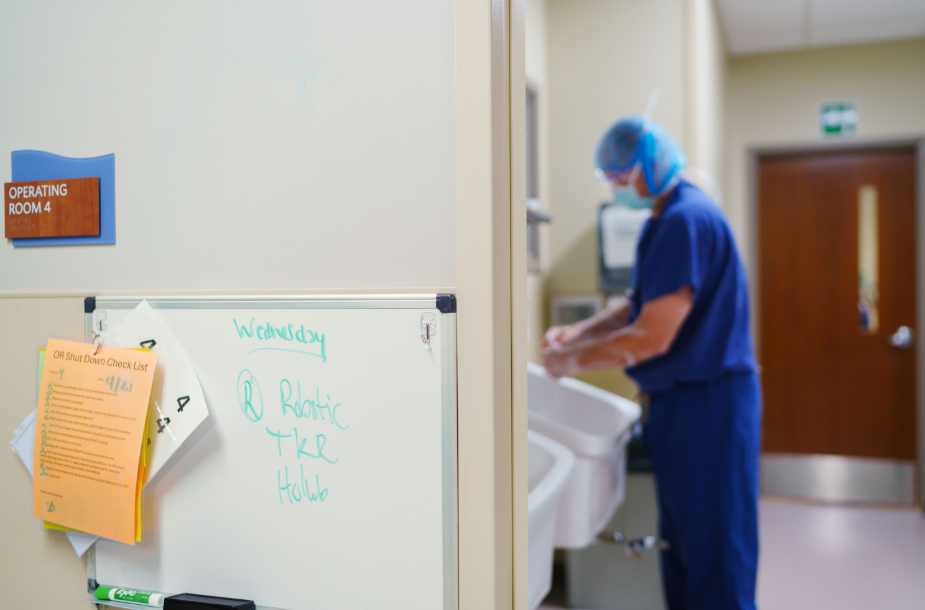In the late 1960s, two Arizona physicians came up with a revolutionary idea.
The anesthesiologists often felt hamstrung at the hospital in which they worked. Jockeying for operating room time was an ongoing chore, and running requests up the chain of command to get approvals for new equipment could take ages. Patients were suffering the brunt of these inefficiencies as well: Many admitted for minor surgeries were often bed bound longer than necessary, causing their hospital bills to balloon.
The pair believed there had to be another way to provide procedures and medical care for conditions that weren't especially urgent, complex or severe. Following that hunch, by early 1970, they founded the U.S.’s first ambulatory surgery center (ASC), a freestanding medical facility that offered same-day procedures. Their vision transformed outpatient care: Today, there are more than 6,300 Medicare-certified ASCs in the U.S. performing tens of millions of procedures, like colonoscopies and knee replacements, a year. To date, roughly 3,500 different procedures are approved for reimbursement by the Centers for Medicare and Medicaid Services (CMS), and they sign off on more each year.
In concert with hospitals, ASCs have helped expand the healthcare landscape: They tend to be specialized to one service line, and they offer the same modern care as hospitals, just on a much smaller scale. But because ASCs have lower overhead than large hospitals, ASC surgeries typically cost less than hospital ones.
ASC procedures also tend to be less expensive even when compared to surgeries done in hospital outpatient facilities, which translates to savings for the healthcare system. According to a 2023 report from the BlueCross BlueShield Association, across thousands of services, prices are substantially higher when performed in the hospital outpatient setting versus in an ASC or physician’s office. For most of these procedures, the price difference grew much faster over time in outpatient settings (27%) than it did in ASCs (11%). Commercial payers appreciate those savings so much that some have begun incentivizing ASCs with higher reimbursements.
The number of ASCs in the U.S. has risen steadily since the 1980s. The COVID-19 pandemic shifted that growth into overdrive, setting off a dramatic surge in demand as hospitals moved to migrate certain cases offsite to free up hospital beds and enhance patient safety. Dozens of new ASCs open in the U.S. each year, a trend that will continue as baby boomers age and require more care.
According to a 2025 survey of hospital and health system leaders, more than 80% of hospital systems reported that they own at least one ASC; compare that to 2019, when only 41% of hospital systems reported they owned a surgery center.
“That many progressive health systems have invested heavily in networks of ambulatory centers has benefitted them tremendously,” says Scott Fraser, founding partner of Fraser Healthcare, a consulting practice focused on ASC growth strategies for medtech, health systems and private equity firms. “When you have a network of ambulatory centers that your physicians are working in, you’re able to increase patient access, lower healthcare costs and refer patient volume into health systems.”
How will this trend continue to impact patient care and the healthcare landscape overall? Below, we take a look—and explore how Johnson & Johnson MedTech is helping shape the future of new care options.
Convenient, comfortable care for patients
Before any surgery, patients must be screened to determine whether an ASC setting is right for them. Many patients, including those with complex medical conditions or who are in frail or poor health, are often better suited to having their procedures in a full-service hospital, where complications can be quickly addressed if they arise. Hospitals also, of course, offer a wide variety of care options.

But healthy patients with certain conditions are often good candidates for procedures at ASCs.
From their perspectives, there are several upsides to choosing an ASC, including the potential to save time.
For one, getting in and out of an ASC (like Orthopaedic Associates of Wisconsin, pictured at right) is straightforward. “ASCs are designed with patient access and convenience in mind, and tend to be standalone, with their own parking lots,” says Benjamin Auzenne, Senior Director, Ambulatory Surgery Center Solutions Sales and Marketing for the orthopaedics business of Johnson & Johnson MedTech. “A patient arrives at an easy-to-navigate building at a specific time and can expect to go home that same day.”
ASC staffers are also trained for specialty treatments, which can lead to efficiency. Because of the large volume of patients served and variety of care offered in a hospital, surgical nurses and technicians there prep and break down operating rooms used by many different specialties and all kinds of procedures. But in a specialized ASC that does a limited number of procedures with the same equipment and systems, physicians and staff can move more nimbly.
That efficiency and focus on outpatient care can offer a smooth ride for patients, and, in many cases, promote a smooth recovery. After surgery at an ASC, following an appropriate amount of time in a recovery suite, patients are encouraged to get moving and walk around. It sounds simple—but walking after surgery rather than staying in bed reduces a patient’s risk for a host of postsurgical complications, from blood clots to infections. “Research shows that the faster someone is ambulating after a procedure, the better their recovery,” says Kara Newbury, Chief Advocacy Officer for the Ambulatory Surgery Center Association (ASCA). Other studies suggest that ASCs can decrease a patient’s length of stay while reducing complications.
And they’re often satisfied with the experience. “Many patients find that ASCs are friendly, comfortable environments,” Auzenne says. “In fact, this patient experience is so important that, in 2025, Medicare-certified ASCs are required to have a standard patient-experience survey performed by a third party.”
Physicians are in the driver’s seat
As pioneering ASC founders Drs. Reed and Ford understood, an ASC can also give a physician-owner a lot of control over their work, allowing them to handpick everything from their operating hours to the technology in their surgical suites.
The American Society for Gastrointestinal Endoscopy found that ASCs help physicians work more efficiently and better manage increased needs for surgical services. By operating in ASCs, physicians get more direct control over their surgical practices, which, in turn, could lead to more satisfaction: Research published this year from the American Medical Association found a link between physician happiness and the level of control they have over their work environments.

Daniel Holub, M.D., performs a robotic knee replacement procedure at Orthopaedic Associates of Wisconsin
Outpatient Ophthalmic Surgery Society (OOSS) president William “Bill” Wiley, M.D., remembers his father being an early advocate for the ASC model.
In the 1980s and 1990s, Dr. Robert Wiley, also an ophthalmologist, recognized that patients with low-risk profiles could safely have their surgeries done outside the hospital. Surgical approaches to cataracts were changing quickly back then, making the procedure less invasive and more suitable for outpatient service. Today, according to OOSS, more than 75% of surgeries for cataract removal are performed at ASCs that specialize in LASIK vision-correcting surgery.
In addition to his partial ownership stake in The Cleveland Eye Clinic, an ophthalmology practice with several locations in Ohio once owned by his father, Dr. Bill Wiley is an owner and medical director of two Ohio ASCs that specialize in LASIK vision correction surgery.
“The benefits of ownership are multifactorial, but one is simply efficiency," he explains. "With baby boomers reaching maturity right now, many patients need cataract surgery. Within a hospital system, the typical wait for that surgery can be three or four months, whereas at an ASC, we’re going to be able to offer it within a month, or even a week or two.”
He continues, “There are also the economics of being a physician in practice today. Having an ASC in addition to a practice can help a surgeon support the economics of their work, so they can provide patients with the best technology and care.”
How industry partners drive growth
As the ASC market expands, med tech companies are finding new ways to offer support.
Cardiac ablation procedures play a critical role in the treatment of various arrhythmias (abnormal heart rhythms). Among these, atrial fibrillation is the most prevalent, yet it continues to be undertreated despite a growing patient population. When hospitals choose to transition care to ASCs, Johnson & Johnson MedTech is well-equipped to provide support, ensuring that patients receive safe and high-quality care regardless of their treatment setting.
These procedures are inherently complex, relying not only on technological advancements—such as 3D mapping, ablation catheters, and intracardiac echocardiography—but also on the expert guidance and support of a clinical account specialist. The size of Johnson & Johnson MedTech’s highly trained clinical team provides the necessary scale to support every hospital and ASC in the market. The company is dedicated to offering comprehensive staff training, technical support, reimbursement education and best practices for safe and efficient procedures in hospitals, all of which are fully transferable to the ASC environment.
CMS recently proposed including cardiac ablation procedures in the ASC setting beginning in 2026. This marks an important step toward expanding patient access to advanced arrhythmia care for millions of Medicare beneficiaries.
“For over 30 years, Johnson & Johnson has led the way in advancing the science and technology behind cardiac arrhythmia treatment. Our innovative product portfolio is uniquely positioned to support safe and high-quality care in ASCs," says Nikki Sidi, Global Head of Marketing and Strategy for Electrophysiology at Johnson & Johnson MedTech. “Our integrated suite of solutions empowers physicians with the tools needed to deliver safe, efficient and economically sustainable arrhythmia care in ASC settings.”
The Vision team (JJV) at Johnson & Johnson MedTech supports ophthalmology ASC growth by equipping ASC owners with best practices, evidence and the latest product and equipment innovations. It also helps professional societies such as OOSS petition CMS to increase reimbursements for new technologies. Just recently, for example, JJV joined OOSS advocacy efforts to increase payment for New Technology Intraocular Lenses (NTIOL), an advanced technology artificial lens used to correct vision during cataract surgery.
JJV also offers general billing guides that could be used to help ASCs avoid time-consuming, costly errors when billing CMS for reimbursement. “Cataract surgery billing and coding has been identified as having a high error rate,” says Tawnya Pastuck, Director, Health Econ & Market Access at Johnson & Johnson Vision. “Our Cataract Surgery Billing and Coding Guide supports our ASC customers with compliance.”
Johnson & Johnson's orthopaedics business also joins in these efforts. Orthopaedics is a critical player in the ASC market: Orthopaedic ASCs comprise the largest share of ASCs in the U.S. overall, at 37%. More and more joint replacement surgeries are done at ASCs every year, a trend that began in 2020, when Medicare signed off on ASC reimbursements for total knee replacements. Total hip replacements were added to the Medicare-payable list for ASCs the following year.
Johnson & Johnson MedTech’s orthopaedics business has a dedicated ASC team that offers ASCs tailored solutions like support for billing and coding, as well as supporting responsible certificate of need laws at the state level. “Whether you’re having your first conversation about starting an ASC or are running one that’s humming along, our ASC team has a solution that can help,” says Auzenne.
That could mean using the power of J&J to design creative financing solutions so that a new or existing ASC owner could acquire cutting-edge technologies or linking it with external partners that can help that owner set up and manage the back end of their business. “Surgery is a small piece of what happens at an ASC,” Auzenne notes. “The rest of it—making sure the ORs are equipped with a specialty lighting system, inventory management, help with CMS accreditation through a third party—there’s a lot to it. Our role is that we’re able to introduce our ASC clients to outside partners who can help with all of those things.”

Dr. Holub prepares for a procedure
On the horizon
As the ASC marketplace continues to grow, new specialties will carve out larger shares.
Cardiology and spine are two specialties that—for some patients and procedures—are expected to grow their ASC footprint, ASCA’s Newbury says. Across the board, she notes, “ASCs are still a relatively small piece of our healthcare puzzle. We think there’s still a lot of room to grow across specialties.”
Bariatric is another fast-growing sector in the ASC marketplace. Elizabeth Dovec, M.D., performed her first weight-loss surgery at a hospital-affiliated ASC in Maryland in 2019. Like many of her colleagues at the time, Dr. Dovec was hesitant. Weight-loss surgery is generally considered safe, although complications can arise, particularly when a patient has high-risk comorbidities such as uncontrolled obstructive sleep apnea, clotting disorders, or unstable coronary artery disease.
“At that time, bariatric surgery in an ASC setting was still considered kind of risky,” Dr. Dovec recalls. But after a few successful cases, her thinking started to change. Patients with the right biometric profile could be safely treated in the ASC, and many had an easier time recovering.
“I did 500 or 600 surgeries at that surgery center over the next three years and saw firsthand how well patients did,” Dr. Dovec says. “I would talk to them after their surgery and almost 100% of them said that they were glad to recover at home, in their own environment.”
Dr. Dovec’s career soon brought her to Florida, where she was recruited to be the inaugural director of bariatric at AdventHealth’s Orlando campus, the second largest hospital in the country. After a little more than a year with the health system, Dr. Dovec decided to go out on her own and start her own ASC. Her 15,000-square-foot Surgical Center of Central Florida, in Winter Garden, opened its doors in March.
Johnson & Johnson MedTech’s surgery business played an integral role in helping Dr. Dovec get her business off the ground, she says. She drew on the expertise of the company’s professional education team, which put her in touch with other ASC physician-owners working in bariatrics who could provide guidance.
“I’ve been in the OR for the last 12 years, not running a business,” Dr. Dovec says. “So I had a lot of questions. The Johnson & Johnson team helped find people who’ve been there, done that and done it well, and set me up with a surgery center in Texas so I could see how their business worked on the administrative side.”
When the time comes, Dr. Dovec says, she’ll eagerly pay that goodwill forward to other physician-owners striking out on their own.
“The connections Johnson & Johnson has made, the resources they provide, the one-pagers, the one-off phone calls—they want you to succeed,” Dr. Dovec says. “I’ll be thrilled when it’s my turn to return the favor.”
Want to learn more about the future of care in the ASC space? Listen to this J&J Institute podcast, Innovation and Transformation in the ASC Space
© Johnson & Johnson and its affiliates 2025. US_ORT_ASCP_399910
The third-party trademarks used herein are the trademarks of their respective owners.
